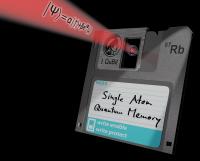A Gerhard Rempe-led team at the Max Planck Institute of Quantum Optics in Garching has stored quantum data in an individual atom.
The quantum state of single photons were written into a rubidium atom and read out after a specified storage period. This development could help design quantum computers and connect one with the other over large distances.
 MPQ Researchers wrote quantum data into a rubidium atom between two mirrors and read it out after a specified time
MPQ Researchers wrote quantum data into a rubidium atom between two mirrors and read it out after a specified time
The devices will be able to carry out rapid computational tasks. They will derive power from their ability to process information stored in microscopic physical platforms including single atoms and photons. The devices will share information between individual parts. Nanomaterial will help store and process the information. The team has discovered that the devices can be monitored to share quantum data between atoms and photons in a restricted manner.
The stored data can be directly processed on the atom, which enables logical operations. It also helps verify whether the data has been accurately written without damaging the quantum state, according to Specht. This helps quickly determine whether or not a computing process needs to be repeated in the event of storage errors.
The team increased the communication between photons and atoms by positioning a rubidium atom between the optical resonator mirrors. Individual photons were inserted into the resonator using weak laser pulses. The photons were reflected to and fro many times increasing the communication between photons and atom.
The photons relayed the data in a polarization form. This could be left or right handed. The quantum state can comprise polarizations and at the same time as a superposition state. During communication, the rubidium atom is stimulated at intervals through emission of another photon. The team was able to insert the atom into a quantum state with the control laser beamed onto the atom simultaneously during communication with the photon.
The atomic spin orientation causes a stable quantum state produced by control laser and photon. Spin attributes a magnetic force to the atom. The quantum state is measured by the magnetic moment. The state reflects the photon's polarization. The state is read by irradiating the atom with the control laser making it re-emit the photon. The fidelity exceeded 90%.
The storage time is restricted by magnetic field fluctuations in the lab. It can be enhanced by storing the data in quantum states, which rejects the magnetic fields. The atom is active in the resonator reducing communication between the atom and photon. Reducing kinetic energy increases efficiency.